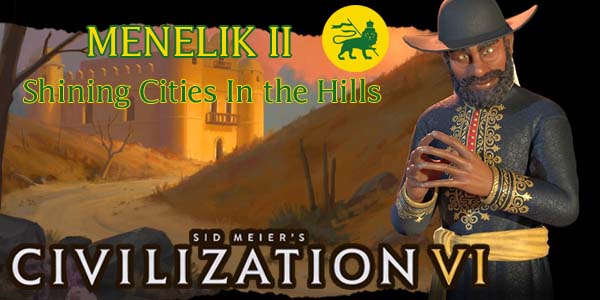
Firaxis recently released the second civilization and leader pack for its New Frontiers DLC Pass. This pack includes alternate versions of the leaders Teddy Roosevelt and Catherine de Medicci, and the new Secret Societies game mode. The main part of the new DLC, however, is the new civilization, Ethiopia, lead by Menelik II. I expect to have the guide for Lady Six Sky of the Maya published within the next couple of weeks. In the meantime, a preview of the Maya guide is already available to my Patrons via Patreon.
Paleontologists believe that Ethiopia was one of the earliest homes of anatomically modern homo sapiens, and that humans crossed through Ethiopia on their way to the Middle East and Asia. Ethiopia is the source for some of the oldest known examples of stone-tipped human weapons and tools, dated at 279,000 years old. Ruins in Bale Mountains suggest the earliest known example of permanent human residence at high altitudes. The earliest kingdoms in Ethiopia were founded out of Semetic traditions, and the region has been heavily influenced by both Islam and Christianity, making Ethiopia a unique melting pot for all three of the Abrahamic religions. Ethiopia and Liberia were the only two African nations to retain their sovereignty during the European colonizations of Africa, and held off an invasion from colonial Italy in 1896 before eventually being conquered by fascist Italy in the lead-up to World War II.
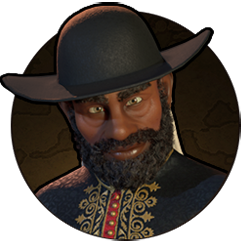
Emperor Menelik II helped to modernize Ethiopia, and also establish Ethiopia as an independent nation after defeating the first Italian invasion in 1896. Menelik II went on to expand Ethiopia's territory and established a Council of Ministers that served long after his death and advised at least two other emperors (and conspired to depose one of them). He adopted a strict prohibition of the slave trade within Ethiopia, and is fondly remembered by the people of Ethiopia for his tremendous benevolence to the poor.
DISCLAIMER:
Civilization VI is still a "living game". Strategies for the game (and for specific leaders and civs) may change as Firaxis applies balance patches, introduces new features, or expands the game through further DLC or expansion packs, or as the Civ community discovers new strategies or exploits. As such, the following strategy guide may change from time to time. I will try to keep it up-to-date, and will make notations whenever changes are made. I'll also post links in the official 2K forums and CivFanatics, where I'll also report any changes made. If possible and practical, I will try to retain the original content of the strategy for posterity.
I welcome any feedback or suggestions that readers wish to offer. Feel free to post on the linked forums, or by posting a comment at the bottom of the page.
This guide is up to date as of the release of the "New Frontiers" Ethiopia DLC pack (July 2020) (ver. 1.0.3.31)
Ethiopia likes to build its cities in the hills. Doing so grants access to the Rock-Hewn church, which grants faith from adjacent hills and mountains. A portion of Ethiopia's hill-folk faith will be converted to science and culture. [More]
71bcd05b-0c24-4591-ace6-ddfc06d3e3e3|0|.0
Tags:Sid Meier's Civilization, Civilization VI, Ethiopia, Menelik II, Aksumite Legacy, council of ministers, rock-hewn church, oromo cavalry, Ethiopian highlands, hill, faith, religion, culture, tourism, volcano, natural disaster, resource
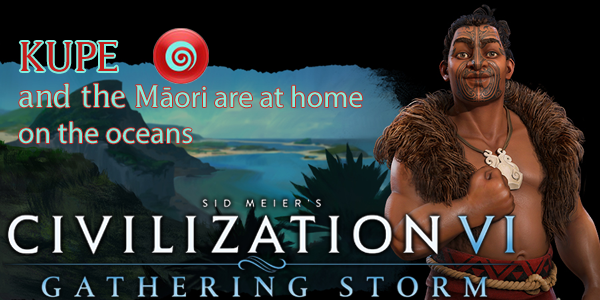
Civilization VI's second expansion, Gathering Storm recently released and has added a handful of new civilizations and leaders. I am hoping to write a strategy for each of them, but I want to start with the civilizations and leaders who are completely new to the franchise. This time, I'll be writing about one of the more interesting of the new civs and leaders: the Māori, lead by Kupe the Navigator.
Natives of the Polynesian Triangle are some of the most successful sea-faring peoples in the history of the world. Between 1400 BC and 900 BC, they had begun sailing large ocean-going craft called "waka", that enabled them to cross from Taiwan, through the Philipines, and out to the Melanesian and Samoan islands. Over the next two thousand years, they managed to colonize Pacific islands as far as Hawai'i, Easter Island, and New Zealand. Some historians even believe that they made it as far as the coast of South America! Sometime in the 13th or 14th century, settlers from Polynesia sailed west, began colonizing New Zealand, conquered the local tribes, and began to culturally diverge from their Polynesian ancestors to become the Māori.
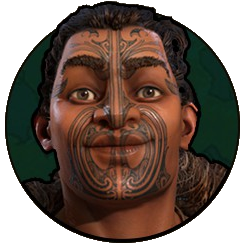
According to legend, the first Polynesian to arrive in New Zealand is Kupe the Navigator, chief of Hawaiki. Kupe is figure in Māori mythology, but like Gilgamesh, Hiawatha, and others, he is believed to be an actual historic figure. Historians have constructed accounts of Kupe's life that differ from the various oral legends of the Maori and Polynesian peoples. According to legends, Kupe sailed from Hawaiki (the mythological birthplace of the Polynesian people), along with great migration fleets, to colonize New Zealand as far back as antiquity, battling sea demons along the way. According to historians, Kupe probably found New Zealand between 750 AD and 925 AD after his cousin drowned on a fishing trip and Kupe fled across the sea with his cousin's kidnapped wife, only to return to Hawaiki later to convince others to migrate to the newly-discovered lands with him.
DISCLAIMER:
Civilization VI is still a "living game". Strategies for the game (and for specific leaders and civs) may change as Firaxis applies balance patches, introduces new features, or expands the game through further DLC or expansion packs, or as the Civ community discovers new strategies or exploits. As such, the following strategy guide may change from time to time. I will try to keep it up-to-date, and will make notations whenever changes are made. I'll also post links in the official 2K forums and CivFanatics, where I'll also report any changes made. If possible and practical, I will try to retain the original content of the strategy for posterity.
I welcome any feedback or suggestions that readers wish to offer. Feel free to post on the linked forums, or by posting a comment at the bottom of the page.
This guide is up to date as of the release of the Gathering Storm expansion's "Great Works and Trade Update" (April 2019) (ver. 1.0.0.317)
Māori are a sea-faring and environmentalist-focused civilization. They can embark and sail across ocean from the beginning of the game, and they get extra yield from unimproved feature tiles. [More]
561fb1a8-9d2a-4002-b81e-1df2c98f29d0|0|.0
Tags:Sid Meier's Civilization, Civilization VI, Civilization VI: Gathering Storm, Maori, Kupe, mana, Kupe's voyage, marae, toa, pa, fort, ocean, embark, forest, rainforest, harvest, resource, unique building, unique melee unit
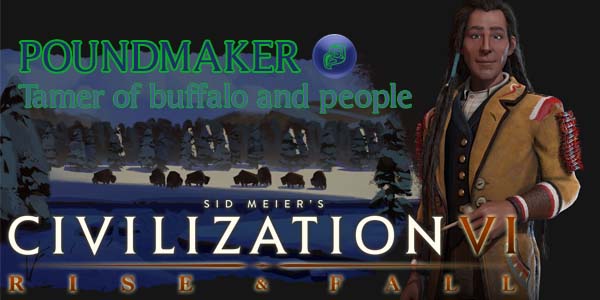
Civilization VI's first expansion, Rise & Fall released earlier this year, and it introduced a few leaders and civilizations that are making their first appearance in the franchise. I hope to be able to write strategies for every one of the expansion civs and leaders, but I'm going to start with the ones that are new to the franchise, and the ones that most utilize the expansion's new features (Era Score, governors, loyalty, and so on). This month, I will be tackling the Cree, lead by Poundmaker.
The Cree are a group of Algonquian-speaking North American First Nation hunter-gatherers. Their numbers have reached hundreds of thousands, and their territory has covered much of mainland Canada (stretching from Newfoundland all the way to western Alberta) and parts of modern-day northern Montana. They were divided into several subgroups based on region and dialect, but their social structure was mostly uniform. They grouped together into a "lodge" consisting of two families related by marriage. Several lodges would hunt and migrate together in a "band", with lodges routinely coming and going between different bands, or forming new bands.

As Cree bands migrated into the Great Plains, those bands began taking up buffalo hunting and herding. The leader of one such band, Pîhtokahanapiwiyin, became famous for his "divine" talent for using song and drum to attract buffalo into a walled pasture called a "pound". This talent, earned him the name Poundmaker from English-speakers. With the numbers of buffalo dwindling in the late 1800's, Pîhtokahanapiwiyin lead his people to Battleford to reaffirm his loyalty to the Queen and to negotiate for food and supplies. The townspeople, fearing an attack, holed up in the fort for several days, refusing to speak to Poundmaker, even though a spy had verified Poundmaker's peaceful intents. Canadian troops arrived a month later and attacked the Cree. The Canadians were routed, but Pîhtokahanapiwiyin ordered his warriors not to pursue, as he did not want a massacre. Despite not having instigated the conflict, Pîhtokahanapiwiyin surrendered to authorities in order to avoid further bloodshed. He was convicted of treason, and sent to prison. His sentence was only for seven months, but he died shortly after release due to a lung hemorrhage that he suffered in prison.
Pîhtokahanapiwiyin's actions, and his many alliances with other native tribes, and treaties with the Canadian government, have earned him a reputation as a skilled negotiator and a man of peace and wisdom. Today, the descendants of Pîhtokahanapiwiyin and his band live in the Poundmaker Cree Nation, a reservation in Saskatchewan, which was founded by Pîhtokahanapiwiyin himself.
DISCLAIMER:
Civilization VI is still very early in its life-cycle (particularly the Rise & Fall expansion. Strategies for the game (and for specific leaders and civs) may change as Firaxis applies balance patches, introduces new features, or expands the game through further DLC or expansion packs, or as the Civ community discovers new strategies or exploits. As such, the following strategy guide may change from time to time. I will try to keep it up-to-date, and will make notations whenever changes are made. I'll also post links in the official 2K forums and CivFanatics, where I'll also report any changes made. If possible and practical, I will try to retain the original content of the strategy for posterity.
I welcome any feedback or suggestions that readers wish to offer. Feel free to post on the linked forums, or by posting a comment at the bottom of the page.
This guide is up to date as of the July 2018 "Red Shell" patch (ver. 1.0.0.262)
Poundmaker had front-loaded bonuses that encourage him to be a trade-based peacemonger in Civilization VI: Rise & Fall, who gains additional bonuses from trade routes (either domestic or foreign) with cities that contain camps or pastures...
[More]
fc0ccceb-184d-4d57-905e-2ea1f5986234|1|5.0
Tags:Sid Meier's Civilization, Civilization VI, Civilization VI: Rise and Fall, Cree, Nehiyawak, Poundmaker, Pihtokahanapiwiyin, Nihithaw, favorable terms, iron confederacy, okihtcitaw, mekewap, alliance, trade route, trader, pottery, food, gold, production, camp, pasture, resource, housing, Canada, first nation, unique improvement, unique recon unit

With Starships released, an expansion for Beyond Earth announced, and support for Civ V apparently done, I thought it would be a good time to take a look back at the game. I'm going to spend a few posts to discuss what Civ V did right, and what it did wrong, so that future games can learn lessons from this iteration's successes and failures.
Here I will present a Top 10 list of my favorite new features, mechanics, and design philosophies in Sid Meier's Civilization V (and its two expansion). These are the elements of the game that stood out the most to me as contributing to the fun and addictiveness of the game, and which push the series in positive directions. Most of these features are things that I would probably like to see return in future sequels.
But even though my intent here is to shine glowing praise on Civ V, I'm not going to ignore the faults of even my favorite features. Some of these mechanics are great ideas, but still suffered from problems in execution. So I won't shy away from constructive criticism where applicable, and I'll make recommendations to improve these great features in the future.
In a future post, I will also look at the things that Civ V got wrong.
Of course, any list of "good ideas" or "bad ideas" is going to be subjective. You may not agree with my opinions, and that's OK. If there's any features, mechanics, or design decisions that you really love in Civilization V, its DLC, or its two expansions, please feel free to leave a comment!
... [More]
e0c9eca7-cd83-4140-a7a1-718f8ff1627f|0|.0
Tags:Civilization V: Brave New World, retrospective, Sid Meier's Civilization, civilization, top 10, Civilization V: Gods & Kings, religion, pact of secrecy, diplomacy, tactics, social policies, resource, archaeology, tourism, natural wonder, city state, great work, Civilization V
UPDATE (September 9, 2014, 2:45 PM Pacific Time)
Shortly after publishing this blog, I came across a forum post that contradicts the information presented in this blog post. As such, I will review the actual source code in the Civilization V dll, do some more testing with the game, and revise the post as necessary. In the meantime, I'll leave the unaltered post here, for posterity. I apologize for the inconvenience.
A lot of buildings in Civilization V mention that they are affected by tiles or resources "near the city", but this quality of being "near a city" is poorly-defined within the game. So what exactly does it mean? I haven't seen any in-depth articles about this topic on the web or in the game's Civilopedia, so I thought I'd outline the important bits here.
Basically, a tile is "near" a city if that city was the first city in its respective empire to claim that tile within its workable radius.
So if you have a single tile or resource that lies between two cities, and both cities' workable ranges overlap that same tile, then that tile is not "near" both cities. It is only "near" the first city that owned that tile. This means that if you go into the city management screen and assign the second city to work that tile, it may receive yield bonuses associated with any improvements or buildings that affect it (such as the stable buffing pasture resources), but the tile's contents will not be considered "near" that second city for other purposes. This includes:
- requirement of an improved Horse or Ivory to build a Circus,
- requirement of an improved Horse, Cow, or Sheep to build a Stable,
- requirement of an improved Iron to build a Forge,
- requirement of an improved Stone or Marble to build a Stone Works,
- requirement of an improved Gold or Silver to build a Mint,
- wonder production bonus from nearby Marble,
- requirement that the city be adjacent to a Mountain in order to build an Observatory,
- trade route income from resource diversity,
- and so on...
Say you have two cities (for example Rome and Antium) whose workable ranges overlap a pastured Horse. Rome was the first city to claim the Horse tile. Rome can, therefore, build a Circus (assuming Trapping has been researched). If you go to the management screen of Antium, you can assign it to work the Horse tile (which prevents Rome from being able to work that tile), but Antium still cannot build a Circus. That is, two cities cannot build a building that requires they both have the same tile.
[LEFT] Rome has annexed a tile containing horses and is building a Circus.
[RIGHT] Later, that tile overlaps with Antium's workable radius, but it cannot build a Circus because the horse was originally claimed by Rome.
Alternatively, if a resource is claimed by a city's culture, but is outside of a city's workable radius (four tiles or more away), then it never counts as "near" that city... [More]
c178571d-236f-4930-b087-5ba4b365ee97|0|.0
Tags:Sid Meier's Civilization, Civilization V, Civilization, Civilization V: Gods & Kings, Civilization V: Brave New World, Civilization: Beyond Earth, building, near, resource, luxury, resource diversity, Arabia, bazaar, Poland, Portugal, mare clausum, trade route, circus, stable, forge, stone works, mint, city borders, owned tiles, Ducal Stable, Civilization V
|

| 12 | | | | | | | 60 | | 11 | | | | | | | 55 | | 10 | | | | | | | 50 | | 09 | | | | | | | 45 | | 08 | | | | | | | 40 | | 07 | | | | | | | 35 | | 06 | | | | | | | 30 | | 05 | | | | | | | 25 | | 04 | | | | | | | 20 | | 03 | | | | | | | 15 | | 02 | | | | | | | 10 | | 01 | | | | | | | 05 |
|